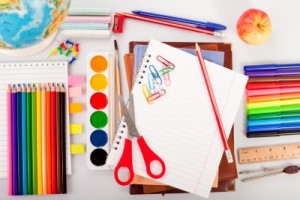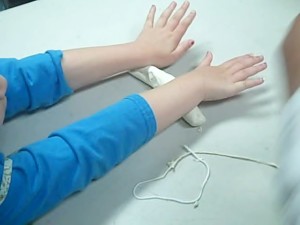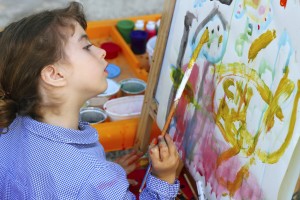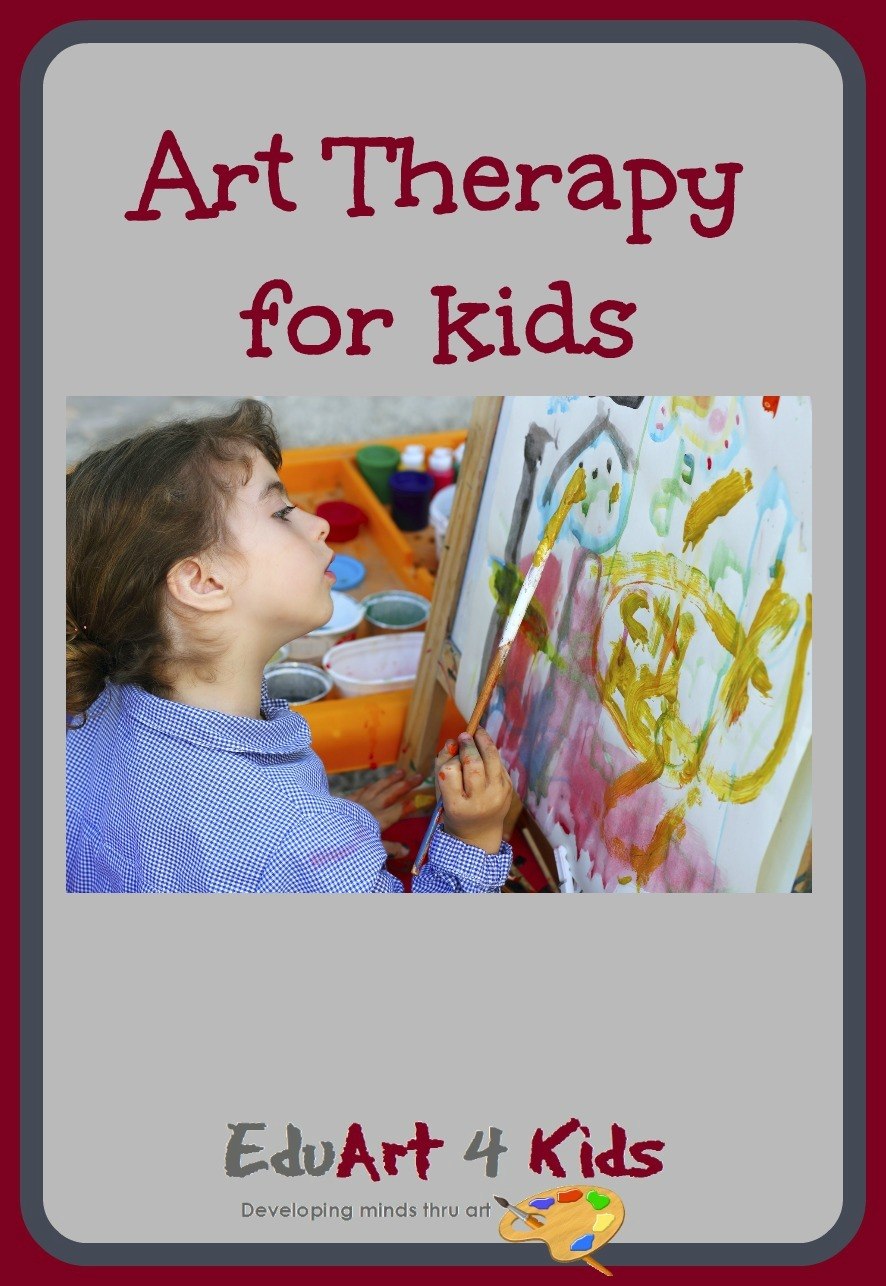
Is art therapy for kids just a bunch of art projects? Is there a way that you can do art therapy with your own children?
The incident that prompted the question in the title was an email I received from a father in a distant country asking me if I could help him give his son some art therapy, as the child had been abused and he thought that maybe he could take the place of a therapist since he did not have the funds to take his son for real therapy.
Since I was very aware of the therapeutic benefits of art for children, I thought Hey! Why not? So I started reading up on art therapy to see if my theory was correct and came to some interesting conclusions.
One of the interesting things I learned from reading books by experts like Cathy Malchiodi was that Art is not therapy if it includes learning and fun. Now art is a wonderful, amazing activity to do with children and I discuss The importance of art in schools for children, however art as a therapy is something much more than giving your children some good clay and painting activities that make them feel good about themselves. If you are not thinking of becoming an art therapist but, still want some good, therapeutic activities you can do with children in art, I address that later on in this post.
I will first discuss what art therapy is for, who it is for, a bit of its history and benefits and will then give you , the layman, some activities that you can do without being a trained art therapist.
For a short post on art therapy you can take a look at this post I did for another blog called Art therapy every child can use.
Classic psychotherapy is a verbal activity. The patient, be it the adult or child sits in a psychotherapists office and shares (hopefully) some of their deep and dark secrets to help heal all sorts of mental illness and some plain old issues like anxiety.
Many, many children and even adults often have a hard time verbalizing their feelings and thoughts. It was then discovered that by using art, children and adults could have a venue to communicate their feelings and ideas by making them visible and tangible on paper. It is much easier to respond to issues and to tell stories about frightening and often catastrophic events when they they are on paper.
There are many types of issues and events that kids and adults go through that can be helped with art therapy. These can range from simple to very complex illnesses:
- Simple separation anxiety is one. Most kids deal with separation at some point in their lives and even though it is not overkill to use art therapy for this as separation can be overwhelming and frightening for young children.
- Getting out issues pertaining to sibling rivalry helps avoid more destructive ways of dealing with feelings.
- When a child has some kind of grief or loss writing or a painting about it is extremely cathartic.
- Children that have been abused find it very hard to verbally communicate about their experiences and are greatly aided by art therapy.
- Children with cognitive issues and learning disabilities can be helped to deal with those issues.
- Children with all sorts of emotional problems.
- Children that have any form of stress or anxiety.
- Any traumatic experience can be helped with art therapy even something as simple as getting lost
- Medical stresses.
- Natural disasters and catastrophic events can be resolved through art therapy.
- Self injurious behavior can be halter.
- Oppositional defiance can be calmed down.
- Even substance abuse can be tackled through art therapy.
The reasons that art therapy can be so helpful are many. Here are a few reasons:
- Words are hard to articulate and don’t convey meaning.
- Art is safe: It’s very non confrontational and kids that have been abused fear talking and retribution. This way their secretes can be let out without them fearing that they said something that will come back to haunt them.
- Anger towards adults is its most difficult towards the ones we love. Kids that have been abused or have other anger towards the adults in their lives, are often conflicted and the art helps bridge the conflict. They learn that one can love someone yet have extreme anger towards them as well. In art, you can hurt someone without anything really happening. Art also allows children to fantasize about being stronger and getting back at the adults that have hurt them in a safe manner.
It has been discovered that traumatic experiences often becomes encoded in ones mind in the form of images almost like a camera, the visual arts therefor helps express these images. Art helps confront these emotions, overcome depression, find relief and resolution over grief and loss. It’s about giving form to a feared object and bringing it under your symbolic control.
Children and often adults usually feel a loss of control in their lives and by putting their fears and angers on paper it is right under their control symbolically. It helps them control their past and their demons and it transfers over into the real world by making them able to deal with it in a better fashion.
Art it is a representation of thoughts on a socially acceptable way and makes them part of the greater social world.
The art also nurtures a sense of self and competence, helps discharges tensions and allows children to represent forbidden thoughts in socially acceptable ways. It is socially acceptable to be angry in your art, it is not acceptable to punch someone you don’t like.
There is also something personally meaningful and authentic when creating with ones hands from ones imagination
The history of art therapy
When did art start being used as a form of therapy?
Art in itself has been used as a tool for communication for thousands of years. It was used before people even knew how to write. However, Margaret Naumberg born in NY in 1882 was one of the first recognized pioneers in the field of art therapy. She is often considered the founder of art therapy here in the United States. She started out as an educator, became a psychotherapist and then joined the two to become an art therapist. The more that progressive education and the fight for humane treatment mental illness became popular in society the more Ms. Naumberg’s ideas gained acceptance.
Margaret founded the Walden school in New York City and based her curriculum on her beliefs in children expressing themselves through creative expression. She saw the importance of the inner life of the child and the ability to express it through art. She felt that that good art had just as much importance for a good education as the acquisition of knowledge.
As a therapist she also began to see, based on the work of Jung and Freud, the process of art therapy being vital to unlock repressed material. She even felt that it was maybe even more vital than verbal therapy.
In the 1930’s psychiatrists began to study artwork to see if there was a link between the art and the mental illness of their patients. This was a bit different than using the art to heal but, is closely related
In the a 1970’s a division sprung up in the ideas of various art therapists. There were those that believed in art as therapy…the natural healing power of making and doing art. These were the ones who believed that most people could benefit from the healing power of art and felt that many teachers and parents could do this as well.
The other school believed in using art as “art psychotherapy” as an addition to the work of verbal psychotherapy. They also believed that it was dangerous trying to be an art therapist if you were not trained. There have many tools have been developed as diagnostic assessment tools that need trained art therapists to administer them and armchair therapist like teachers and parents can only help derail the therapeutic benefits.
Art therapy benefits
Since the creative process involved in the making of art is not only healing but life enhancing as well, it only goes to say that children and adults that are involved in art making have their lives well enhanced.
Doing art increases the brain levels of serotonin which is the chemical used to help lift depression, so the more art a child or adult is involved with the better they will feel. When they do art they grow deeper as well as bigger, broader as well as older, stronger inside as well as outside. It is about gaining awareness, understanding, accepting, liking and control of ones feelings.
The therapy also helps gain clarity and express and cope with all sorts of feelings like jealousy, anger, fear and aggression.
Aside from the feelings and tensions the art therapy helps discharge, the art nurtures a sense of self and competence as kids feel competent when they master a medium. It helps them develop a respect for themselves. When children and adults have respect for themselves their behavior reflects their new feelings about themselves.
That is also because the making of art is healing and life-enhancing. increases awareness of self, helps cope with symptoms, stress, and traumatic experiences, enhances cognitive abilities, and makes one enjoy the life-affirming pleasures of artistic creativity.
Some art therapy activities and ideas you can do on your own with young children without being an art therapist
Art activities themselves are healing if you are doing art with kids without telling them how they should create their art.It allows them the the opportunity to use their creative expression in so many different ways.
There are many activities that you can do with children on your own that that have their own therapeutic benefit. Even though you should never attempt to take the place of an art therapist there activities that you can do with children that are therapeutic and helpful for them without crossing the boundaries of stepping on the toes of a trained art therapist.
It is very important to differentiate between crafts and real art for kids. It is super important not to impose your own ideas of what the art should look and how the children should create it.
Even thought there are many great art activities, I am going to talk about 4 of them that can be helpful to all parents and teachers. Three of them are more standard type art activities, and one is more geared towards specifically art therapy. Clay, painting, early reading books and mandala drawings are 4 activities you can incorporate into your children art activities to help them get some more therapeutic benefit out of the activities.
1-Clay work is probably then number one activity I would think of automatically when thinking of great tension reducers. It is soft, sensory, malleable and conforms to the child’s touch. There a few types of clay you can use, but the wet, gray clay or the white porcelain clays is best for this purpose. You can find out more on how to use these types of clay by checking out this post on modelling clay as well as the one linked to before this one.

2-The second activity is painting which probably speaks for itself. Check out the post on painting for kids, which will give you a good start on activities you can give children.

3-Early reading books
When a child has had a frightening or disturbing experience you may want to make a book out of it with him or her. Take a few sheets of paper, staple them together, have the children draw about what happened and then write it as they dictate to you. Of course, this is not an activity that can be done with very difficult scenarios such as abuse, but can be used for more frightening, every day occurrence.

Many years ago when I was teaching preschool, a little girl had a robbery in her home. She talked about it non stop until I sat down with her to make a book. She drew the pictures and told me what happened. She carried this book around with her for days, until she had it out of her system and she stopped talking about it.
You can make books about the arrival of a new sibling in the family or a family trip. You never know what will come out of those drawings.Once the children get used to making books for everyday events, it will be natural for them to make a book about a disturbing even.
4-The fourth activity are what are called mandala drawings.
Mandala drawings are very big in art therapy and they are supposed to be form of guided meditation that can promote peace and balance in your life.
Carl Jung writes: “When I began drawing the mandalas, I saw that everything, all paths I had been following all the steps I had taken were leading back to a single point – namely, to the midpoint. It became increasingly plain to me that the mandala is the centre. It is the exponent of all paths. It is the path to the centre, to individuation.”
Mandala drawings are abstract designs that start with l point in the middle of a circle and keep expanding outwards. You can add many a series of detailed shapes and patterns. They are an easy and fun way to draw something pretty but, are also supposed to help you concentrate on the center of your mandala whilst drawing. This helps you with an anchor point to fall back to as your mind wanders.
To start out by having the children draw mandalas here are some simple instructions for one kind.
- Draw a circle on a blank piece of paper. Use either a compass or a bowl to make it really round.
- Make a dot in the middle of the circle.
- Have the children make lines from the dot to the edge of the paper, try to keep these symmetrical.If you keep it symmetrical you should get about 8 lines.
- Have them draw a small shape in the middle with a pencil or marker. you can use a diamond, square, circle or star.
- Draw another shape after this one and keep repeating all around the ring.
- You can use all kinds of shapes on the lines, between the lines and can repeat many of the same shapes. The more space you have the more lines you can draw.
- You can then add shapes inside other shapes.
- When it is all done it can be colored in with markers.
If you want to see some some more detailed work then check out how to draw a mandala
If you are working with a group and want to know about some more classic art therapy type activities then here a few below.
Art therapy group activities
Here a few activities to do with children in a group that is going to concentrate on the emotion of anger.
- Give each child a paper and ask them to make an image of a time when they felt very angry. After they arr all done, ask them to make a second drawing showing what that incident made them feel like doing. Remind them that its not for real so anything goes. Discuss all of the children’s 2 pictures in the group. After you are done have them draw a third picture showing an acceptable way of handling the anger.
- Have each child make an image of what they think the monster that lives in each of us looks like. the monster owns all of the bad feelings we may have. Then have them share what feelings this monster has with the other kids. then they should each make a picture of the cause of the anger monster. After that they can talk about the parts in the image that they would like to change.
- Have them make a picture of their anger using a large piece of paper. Discuss with them what it was that made them feel that way. Next have them tear up this paper and let them tell how how it felt to destroy that paper with the emotion on it.Then use the pieces of the torn paper to make a new picture by gluing it onto a different piece of paper.You can discuss with them the proper ways to express their anger.
- The fourth and last activity would be to have the children draw an image of an anger monster. Then have them put thought bubbles near the monster and have them write (or dictate)what the monster is saying and what he would be feeling. then repeat the same activity but, ask them to draw a warm fuzzy monster that holds love this time.
If you would like to know how to become and art therapist and if you have what it takes to become one
As you already know, you can do do lots of healing type of art activities that fall under the banner of art therapy without having to be a trained art therapist. To an untrained eye the activities look the same but when you are a trained art therapist you are listening with a psychological sophisticated ear and will know where there are developmental conflicts in family dynamics and other areas.
If you are really taken by the field of art therapy you must know who and what you are treating plus you must understand the creative process, the language of art and you must be well schooled in therapy.
Art therapists do not only work as private therapists. They also often may work as part of a team which includes other professionals like physicians, nurses, rehabilitation counselors, social workers, and teachers. You often have to decide together on the needs and direction the therapy should take for a patient.
It takes years of training, supervised work and you need clinical guidance before becoming an art therapist
Before you even take the step to become an art therapist you should know some of the qualities of a good art therapist which will help you decide if you fit the bill.
- You need to love children and have a sincere enjoyment of them. There are too many people working with children that don’t really like them or enjoy them and I’m sure you’ve met many of them, we all have.
- You need to be able to deal with children under stressful environments. Kids can stimulate very negative reactions and you need to be able to remain calm.
- You must be comfortable with childish thought and feelings, you will need to make peace with your primitive self. Children and people have lots of primitive feelings that have to be accepted.
- You will need to be consistent and dependable.
- You need to be able to communicate and receive messages in non verbal ways
- It is also important to know not to give the child too much applause and praise as it can promote unhealthy narcissism and dependency or response of others. The typical scenario of the child saying how’s my picture…
If you have these qualities then you can know that you will make an excellent art therapist and should continue with your research.
Pin to save for later






